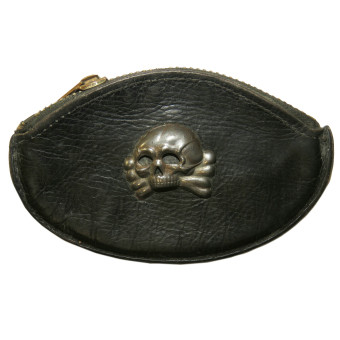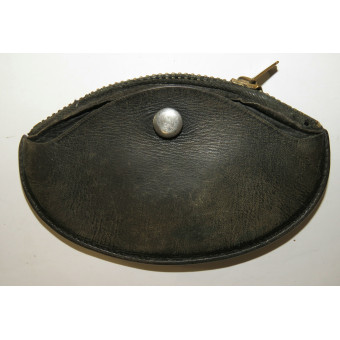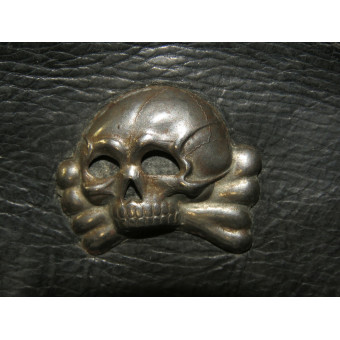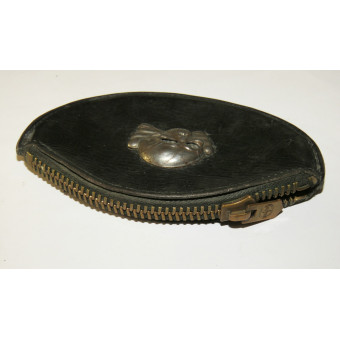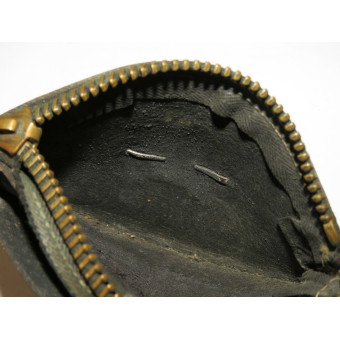Wallet of an SS Soldier or Serviceman from the 1st, 2nd, or 5th Cavalry Regiment
Wallet of an SS Soldier or Serviceman from the 1st, 2nd, or 5th Cavalry Regiment
This wallet belonged to an SS soldier or a serviceman from one of the Wehrmacht’s cavalry regiments—namely the 1st, 2nd, or 5th Cavalry Regiment. A traditional skull (Preußischer Totenkopf) is mounted in the center of the wallet, indicating the owner’s affiliation with the SS or with cavalry units that employed this symbol on their uniforms and equipment.
Totenkopf Badge (Totenkopfabzeichen)
Since 1935, Totenkopf badges were made of lightweight metal and worn on caps, positioned between the national cockade (Hoheitsabzeichen) and the wreath of oak leaves. These badges were attached to headgear using special fastening pins.
In some units, Totenkopf badges were also worn on field caps, placed between the cockade and the eagle. This practice spread during the war, and they even began to be worn on tropical caps. The Nord Cavalry Regiment, formed in 1943, was renamed 5th Cavalry Regiment (Kavallerie-Regiment 5) on June 3, 1944 (order GenStdH/Org. Abt. 1/4843/44).
At the same time, it inherited the tradition of the old 5th Cavalry Regiment (Kav.-Rgt. 5), which had been disbanded at the start of the war. From its foundation, the Nord Regiment considered itself the heir to these traditions and unofficially adopted the wearing of the Totenkopf on caps.
Only on August 27, 1944 (order OKH/GenStdH/Org. Abt. Nr. II/51394/44, later changed to September 6, 1944), was the 5th Cavalry Regiment officially authorized to wear the Totenkopf as a traditional insignia, placing it on the cap below the cockade.
However, this practice was only possible when using a combined cockade and eagle insignia; otherwise, the Totenkopf was traditionally placed between the cockade and the eagle.
Later, the regiment was given the name "Generalfeldmarschall von Mackensen", and armbands with this name were introduced, along with Totenkopf insignia on shoulder boards and epaulettes, as mentioned in other sources.
Totenkopf in Cavalry Regiments
At the beginning of the war, cavalry regiments were disbanded, and their units were integrated into reconnaissance battalions (Aufklärungs-Abteilungen). Despite this, soldiers from former cavalry units continued to wear Totenkopf badges in their new formations, and this practice was apparently unofficially tolerated.
Prussian Totenkopf (Preußischer Totenkopf)
This symbol referred to the traditions of the Prussian army, where Cavalry Regiments No. 1 and No. 2 wore such badges on their headgear. Their design followed traditional skull representations and was round in shape.
In cavalry units, the Totenkopf was only permitted in certain formations, such as the 1st Cavalry Regiment (1. Kavallerie-Regiment), particularly among musicians (Trompeterkorps) and the 1st Squadron, which preserved the traditions of the Blücher Hussars (Blücher-Husaren).
Wallet of an SS Soldier or Serviceman from the 1st, 2nd, or 5th Cavalry Regiment
This wallet belonged to an SS soldier or a serviceman from one of the Wehrmacht’s cavalry regiments—namely the 1st, 2nd, or 5th Cavalry Regiment. A traditional skull (Preußischer Totenkopf) is mounted in the center of the wallet, indicating the owner’s affiliation with the SS or with cavalry units that employed this symbol on their uniforms and equipment.
Totenkopf Badge (Totenkopfabzeichen)
Since 1935, Totenkopf badges were made of lightweight metal and worn on caps, positioned between the national cockade (Hoheitsabzeichen) and the wreath of oak leaves. These badges were attached to headgear using special fastening pins.
In some units, Totenkopf badges were also worn on field caps, placed between the cockade and the eagle. This practice spread during the war, and they even began to be worn on tropical caps. The Nord Cavalry Regiment, formed in 1943, was renamed 5th Cavalry Regiment (Kavallerie-Regiment 5) on June 3, 1944 (order GenStdH/Org. Abt. 1/4843/44).
At the same time, it inherited the tradition of the old 5th Cavalry Regiment (Kav.-Rgt. 5), which had been disbanded at the start of the war. From its foundation, the Nord Regiment considered itself the heir to these traditions and unofficially adopted the wearing of the Totenkopf on caps.
Only on August 27, 1944 (order OKH/GenStdH/Org. Abt. Nr. II/51394/44, later changed to September 6, 1944), was the 5th Cavalry Regiment officially authorized to wear the Totenkopf as a traditional insignia, placing it on the cap below the cockade.
However, this practice was only possible when using a combined cockade and eagle insignia; otherwise, the Totenkopf was traditionally placed between the cockade and the eagle.
Later, the regiment was given the name "Generalfeldmarschall von Mackensen", and armbands with this name were introduced, along with Totenkopf insignia on shoulder boards and epaulettes, as mentioned in other sources.
Totenkopf in Cavalry Regiments
At the beginning of the war, cavalry regiments were disbanded, and their units were integrated into reconnaissance battalions (Aufklärungs-Abteilungen). Despite this, soldiers from former cavalry units continued to wear Totenkopf badges in their new formations, and this practice was apparently unofficially tolerated.
Prussian Totenkopf (Preußischer Totenkopf)
This symbol referred to the traditions of the Prussian army, where Cavalry Regiments No. 1 and No. 2 wore such badges on their headgear. Their design followed traditional skull representations and was round in shape.
In cavalry units, the Totenkopf was only permitted in certain formations, such as the 1st Cavalry Regiment (1. Kavallerie-Regiment), particularly among musicians (Trompeterkorps) and the 1st Squadron, which preserved the traditions of the Blücher Hussars (Blücher-Husaren).


